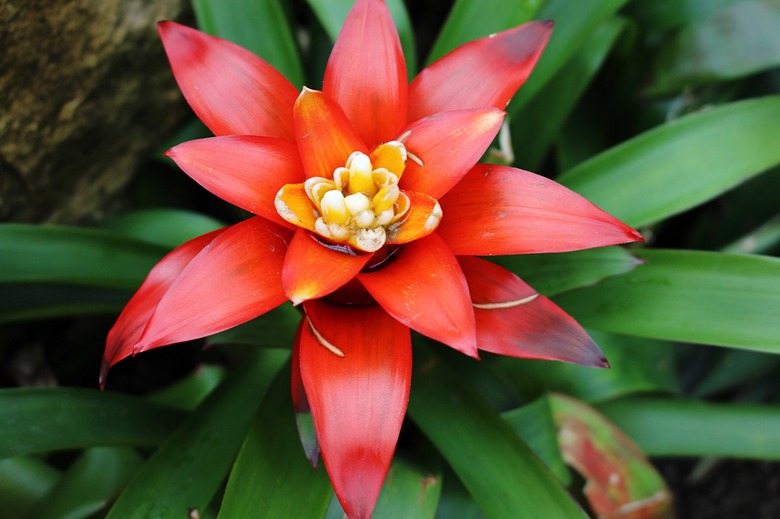What Are Some Important Producers Of The Tropical Rainforest?
The producers of an ecosystem are those components that make other life possible. They support animal life using nutrients from the soil and water, along with sunlight, to create the most basic form of energy. As in other biomes, the producers of the tropical rainforest are plants; because of the heavy rain, warm temperatures and high humidity, some of these producers cannot be found anywhere else in the world.
TL;DR (Too Long; Didn't Read)
Important producers of the tropical rainforest include bromeliads, fungi, lianas, and canopy trees.
Bromeliads Survive on Air and Water Alone
Bromeliads Survive on Air and Water Alone
The members of this plant family come in a variety of sizes and shapes, and include some of the most unusual-looking members of the plant kingdom. Perhaps the most well-known of the family is the pineapple, with its slender, leathery leaves arranged in the distinctive rosette pattern that identifies the members of the family.
Most of the members of this family attach themselves to trees or rocks by sticky roots rather than growing in the soil. These plants absorb all that they need to survive from the air and the water, meaning that not only are they well-suited to the damp rainforest atmosphere, but they do not take nutrients away from other soil-dwelling plants. The rosette shape of the tough leaves allows the plants to hold water, and many bear fruit.
Fungi Provide Nutrients for Other Plants
Fungi Provide Nutrients for Other Plants
Fungi are also producers crucial to the rainforest ecosystems, but not in the traditional way that most organisms are considered producers. Fungi — and other members of the family that are considered saprophytes — are decomposers. Instead of getting their energy from the sun or nutrients from the ground, fungi get their nourishment from dead and decaying material.
These organisms have filaments which they extend into fallen trees and other decaying plant matter. They then absorb elements in much the same way a plant absorbs nutrients from the soil, in the process breaking down the structure of what it is feeding on. The decaying material is in turn slowly returned to the soil, where nutrients from the process are then available for plants to absorb and use.
Lianas Provide Food and Shelter for Animals
Lianas Provide Food and Shelter for Animals
Lianas are a type of vine rooted in the ground that begins life resembling a small, bushy shrub. Because the most sunlight is available at the top of the rainforest canopy, lianas have adapted to use other plants as stepping stones to reach that precious sunlight. They will often begin to grow vine-like structures that rely on trees for support; because they attach to trees to stabilize themselves rather than having any kind of structural integrity themselves. Lianas often devote most of their nutrients to developing thick leaves and adaptations — including spikes — that secure them to their host tree.
In addition to being a major food source for a wide range of animal species, lianas tend to form large mats over their hosts. This allows them to provide not only food but also shelter for animals.
Canopy Trees Tower Over All
Canopy Trees Tower Over All
The canopy trees are the tallest trees in the rainforest, with their upper branches reaching up to the unhindered sunlight. Most of these trees have tall, thick trunks with no branches until the very top. The canopy itself can be up to 40 feet deep, supporting intertwined branches that are all struggling for sunlight.
Canopy trees have adapted to make the most of what sunlight is available, with lower leaves that are usually a slightly different color to capture different wavelengths of light. Reproduction can be difficult for these trees, with seeds needing to travel a long way through other, lower plant life before reaching the ground. To adapt, the trees produce a large number of seeds and fruits, which provide a food source for countless animals that spend their entire life in the canopy.
Cite This Article
MLA
Durkee, Debra. "What Are Some Important Producers Of The Tropical Rainforest?" sciencing.com, https://www.sciencing.com/important-producers-tropical-rainforest-8385843/. 22 November 2019.
APA
Durkee, Debra. (2019, November 22). What Are Some Important Producers Of The Tropical Rainforest?. sciencing.com. Retrieved from https://www.sciencing.com/important-producers-tropical-rainforest-8385843/
Chicago
Durkee, Debra. What Are Some Important Producers Of The Tropical Rainforest? last modified March 24, 2022. https://www.sciencing.com/important-producers-tropical-rainforest-8385843/
